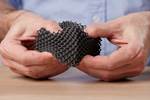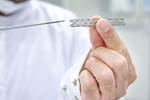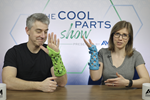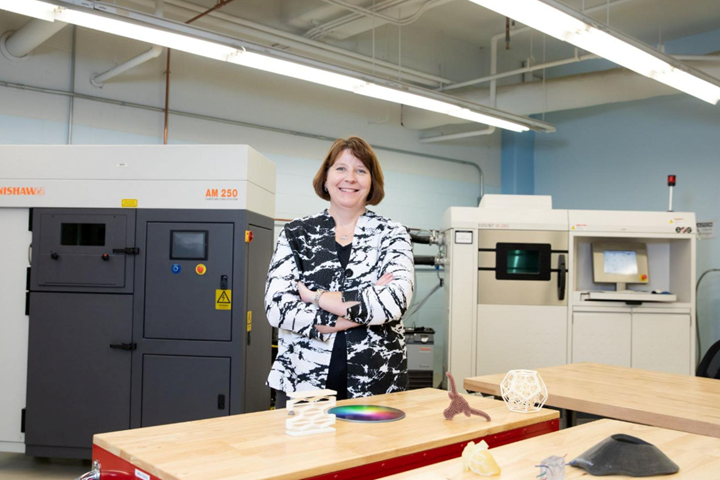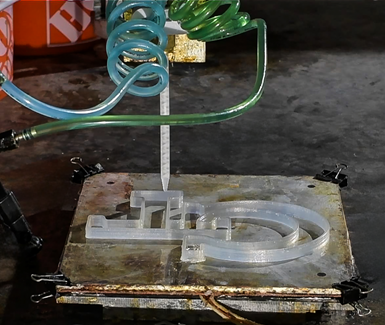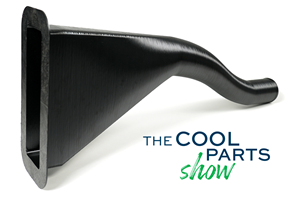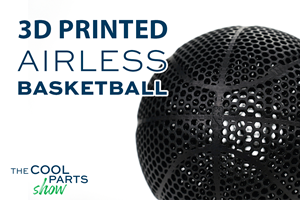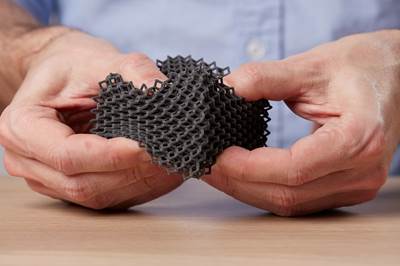Share
Read Next
Creating flexible medical devices requires innovations in design, materials science and advanced manufacturing.
A research team, comprised of members from The University of Texas at Austin (UT), Georgia Institute of Technology (Georgia Tech), Penn State University (Penn State) and Actuated Medical Inc. is developing new methods of 3D printing medical devices such as noninvasive ventilation masks to offer an adaptive shape-changing quality for the customized fit of individual patients.
As of July 1, Seepersad moved to teach mechanical engineering at her alma mater, Georgia Institute of Technology. Seepersad previously taught mechanical engineering at The University of Texas at Austin. Members of both universities are participating in the project. Photo Credit: The University of Texas at Austin
The five-year project aims to investigate and refine the process of 3D printing shape-adaptive medical devices through a grant received from the National Science Foundation’s LEAP-HI (Leading Engineering for America’s Prosperity, Health and Infrastructure) program.
I had the opportunity to speak with one of the project’s leaders, Carolyn Seepersad, professor of mechanical engineering at Georgia Tech. In addition to Seepersad, the all-female team is comprised of three co-leaders from Penn State: Mary Frecker, department head and professor of mechanical engineering, Zoubeida Ounaies, professor of mechanical engineering, and Lorraine Dowler, professor of geography, women’s, gender and sexuality studies. The research group is also partnered with Maureen Mulvihill, president and CEO of Actuated Medical.
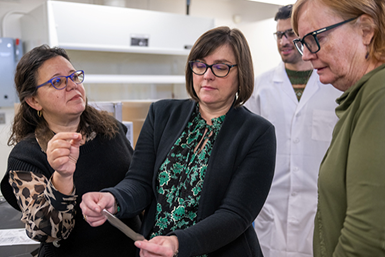
From left to right, Ounaies, Frecker and Dowler are co-leaders from Penn State University working with Seepersad on the project. Photo Credit: Penn State University
Dowler’s role as the social scientist is to observe how the all-female team interacts, collaborates and thinks throughout the entirety of the project to better understand and promote diversity in STEM.
To round out the group, Maureen Mulvihill, president and CEO of Actuated Medical, a Pennsylvania-based medical device company is working in tandem with the team.
Seepersad says the project will pioneer new ways to 3D print customizable medical devices with enhanced range of motion while using a variety of materials. The researchers envision printing smart devices with the capability to change shape after they have been manufactured for an optimized fit. Magnetic particles contained in the 3D printed material offer a means of achieving this shape adaptation.
The aim is to produce noninvasive ventilation masks using a single AM process with the capability to customize each device. This requires a computationally effective approach to ensure printability.
The Blueprints
To design the 3D printed, shape adaptive devices, there are numerous challenges spanning materials and design.
As one motivating example, the team is envisioning noninvasive ventilation masks that are functional and comfortable for all demographics, but especially for children.
At present, pediatric ventilation masks are not made with comfort in mind. According to Seepersad, children often acquire pressure sores from wearing these masks for extended periods of time.
To avoid this, shape-adaptive, noninvasive ventilation masks would offer a way in which to change the pressure points that are being strained.
The smart masks can adjust to accommodate different patients’ unique anatomy and adjust to redistribute pressure as needed.
Shape-adaptive masks would then offer a comfortable alternative for the patient, prevent materials waste (as masks would be reusable) and ultimately prevent further injury. This technology can open doors for additional medical and dental devices.
How is shape change achieved through AM? The answer entails the right 3D printing technology, the correct balance of active properties within durable yet flexible materials and a design process that enables shape change after a print.
The Manufacturing Side
Seepersad says the research team is using 3D printing technology built in-house (most similar to desktop extrusion printers) and implementing the use of robotic arms to fabricate the shape-changing device.
The 3D printing process itself is reactive extrusion 3D printing.
Right now, the team is experimenting with thermoset polymers, whereas the traditional desktop extrusion process primarily utilizes thermoplastics.
One of the research group’s REAM printers (built in-house) is depicted above as it 3D prints a Georgia Tech logo. Photo Credit: Georgia Tech
During the 3D printing process, multiple-liquid feedstocks are pumped through a mixing nozzle before being deposited quickly to accommodate a rapid curing progression.
At a minimum, two reservoirs provide two components of the liquid feedstock: a resin and a catalyst that serves as the hardener.
Additional reservoirs can be added to incorporate fillers such as magnetic or conductive particles to facilitate shape change. The precursor materials are shelf stable at room temperature and can sit in their reservoirs for as long as needed before use. When combined, the liquids crosslink and harden.
“It’s like a two-part epoxy from Home Depot where there are special types of epoxies that harden and gel very quickly,” says Seepersad.
The team utilizes a pumping system to direct the precursors to a mix manifold at a specified rate. There is a 4:1 ratio of mixing at present (four parts resin to one part hardener). The precursor materials come into contact after exiting the mix manifold and entering the mixing nozzle.
The team is investigating various materials as well as the speed at which the feedstock is pumped and a variety of other process variables. These variables are adjustable as the project progresses, and the team continuously explores different combinations. AM affords the ability to easily implement different materials to test with quick results and real-time feedback.
The mixing nozzle itself can be either active or passive and operates by effectively folding the different precursors together.
The nozzles are disposable and require replacing after each print cycle. The material gels and hardens so quickly it often leaves residue behind, therefore requiring a new nozzle.
The current challenge the team is facing with its in-house 3D printing application is the stopping and starting process. The goal is to achieve a continuous, uninterrupted print and in order to do so, the team must reengineer the deposition paths.
“As we continue to refine this process, we find the solution lies in the intersection between project innovation, material science, design, and social science, says Seepersad.
Seepersad says the project aims to characterize and refine this 3D printing process for a variety of reasons including:
- Improved geometric fidelity.
- Creation of a turnkey process that either exceeds or is equivalent to the current capabilities of thermoplastic extrusion processes.
As of now, Seepersad says the team is seeing excellent surface finish results and steady control over dimensions with prints so far.
Overhangs and bridges are an additional topic of experimentation. Using an engineered resin, the curing rate of the resin and the time elapsed between layers interacts to become a finicky part of process design.
Additionally, the team has been working with spatial grading for this project, in terms of manipulating magnetic particles. The goal here is to improve accuracy and control with the magnetic properties of the particles as these are what will inevitably allow the shape of the ventilation masks to change once printed.
How? The shape adaptive aspect of 3D printing the ventilation masks stems from the idea of magnetic force being a potential catalyst for enabling shape shifting.
To this extent, the research group is focused on developing an active mixing technology (for spatial grading of magnetic particles). This process still needs to be refined but ultimately will increase precision in the builds to come.
The manufacturing side aims to clearly define the additive process, understanding both limitations and variability.
The Design Side
To 3D print medical devices, such as shape-adaptive, noninvasive ventilation masks, knowledge of design for additive manufacturing (DFAM) is necessary. Seepersad, along with one of her co-leaders, Mary Frecker, are spearheading this element of the project.
Frecker and Seepersad are using machine learning models to map the interactions between variables in the project’s dataset to guide the design of parts and the process itself. The two are establishing analytical modeling for quick predictions of the shape-changing behavior of the parts being designed and then prototyped.
The elements of optimization for the composition of material and spatial grading of active magnetic particles are ongoing experiments critical to the project’s success. The vision for the completed 3D printed ventilation masks is to enable shape change by means of magnetism and heat (via a hot water bath).
What will this look like when applied? If magnetic particles are arranged properly in the mask, the application of heat and a magnetic field to the mask would allow it to shift and form to the patient’s best fit. Subsequently, if the mask were heated again, it could be manipulated to return to its original shape.
To achieve this, the team is modeling more complex structures and incorporating findings so far about the process and its limitations to discover the best use of computational models for ensured accuracy of the intended shape-shifting design.
The Materials
Leading the material science portion of the project, Zoubeida Ounaies is working to better characterize the properties and behavior of the materials serving as feedstock for the additive process.
One such phenomenon being observed is the addition of viscosity-enhancing agents to the current materials. The fluids being pumped need to be shear thinning, such that the viscosity is quite high at low speeds — enabling the material to hold its shape after deposition — but relatively low at higher speeds making it easier to pump. This combination enables printability.
The team is also investigating fillers that enable shape change, such as magnetic particles and conductive particles and their effect on the printability of the materials as well as shape-changing behavior post-print.
The team has been investigating different epoxies, as these harden quickly and provide excellent strength. Additionally, the team is exploring softer, more biocompatible materials for medical application.
In order to find the right viscosity, speed of mixing, and printing optimization, a better understanding of the effect of additives on the resins and the final properties of the hardened material is crucial.
Currently, the project is working to achieve finer control of the distribution of magnetic particles within a printed part and how the concentration of particles affects the shear thinning behavior the team is seeing. Other techniques are being implemented, such as pretreating particles to assist them in distributing more homogenously.
At present, the goal for the material science side is to experiment and deploy different additives to promote not only shape change, but strength, durability and flexibility. And of course, printability.
The Social Science Slice
An additional layer to this project is anchored in social science. The all-female team is being studied by social scientist Lorraine Dowler to ultimately support diversity in the engineering and AM fields.
Dowler will note how each leader engages with their corresponding graduate students, how the team interacts as a whole and what steps are being taken to achieve results. During the process, Dowler has been interviewing the project co-leaders as well as their graduate students.
Seepersad says Dowler’s findings so far have been fascinating. “During
group meetings, Dowler could not tell whose graduate students were whose. As leaders, we try to provide consistent feedback and be supportive to everyone on the team,” she says.
Dowler will study the team’s progress until the project concludes.
Related Content
Understanding PEKK and PEEK for 3D Printing: The Cool Parts Show Bonus
Both materials offer properties desirable for medical implants, among other applications. In this bonus episode, hear more from Oxford Performance Materials and Curiteva about how these companies are applying PEKK and PEEK, respectively.
Read MoreConcept Sneaker Boasts One-Piece 3D Printed TPU Construction
The Reebok x Botter Concept Sneaker Engineered by HP premiered at Paris Fashion Week, hinting at manufacturing possibilities for the future of footwear.
Read MoreAircraft Ducts 3D Printed in Composite Instead of Metal: The Cool Parts Show #68
Eaton’s new reinforced PEKK, tailored to aircraft applications, provides a cheaper and faster way to make ducts compared to formed aluminum.
Read MoreAirless Basketball Shows Promise of 3D Printed Lattices: The Cool Parts Show Bonus
Successfully matching the performance of a standard basketball demonstrates the control possible over the mechanical properties of digital materials.
Read MoreRead Next
Formlabs Develops Tough Elastomer Powder for Strong, Functional, Skin-Safe Parts
The TPU 90A powder is the first elastomer material for its Fuse Series 3D printers and which enables durable, skin-safe parts at a low cost for a variety of industries, including health care, consumer goods, manufacturing and engineering.
Read MoreOvercoming Challenges with 3D Printing Nitinol (and Other Oxygen-Sensitive Alloys) Through Atmospheric Control
3D printed nitinol has potential applications in dental, medical and more but oxygen pickup can make this material challenging to process. Linde shares how atmospheric monitoring and the use of special gas mixtures can help maintain the correct atmosphere for printing this shape alloy and other metals.
Read MoreActivArmor Casts and Splints Are Shifting to Point-of-Care 3D Printing
ActivArmor offers individualized, 3D printed casts and splints for various diagnoses. The company is in the process of shifting to point-of-care printing and aims to promote positive healing outcomes and improved hygienics with customized support devices.
Read More


